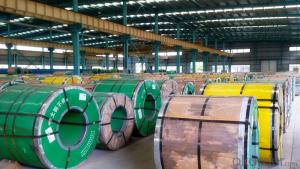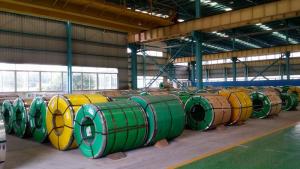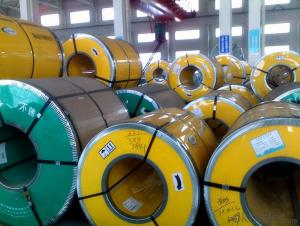Hot Rolled Stainless Steel Coil 304 Grade No.1
- Loading Port:
- China Main Port
- Payment Terms:
- TT OR LC
- Min Order Qty:
- -
- Supply Capability:
- -
OKorder Service Pledge
OKorder Financial Service
You Might Also Like
Type | Hot Rolled Stainless Steel Coil 304 |
Thickness | 3.0mm-4.0mm |
Width | 550mm, 650mm, 1000mm, 1219mm, 1240mm, 1500mm |
Length | according to weight |
Brand name | CNBM |
Standard | ASTM, AISI, DIN, GB, JIS etc |
Material | 304 |
Application | Foodstuff, Gas, metallurgy, biology, electron, chemical, petroleum, boiler, nuclear energy, Medical equipment, fertilizer etc |
Package | Standard export sea-worthy packing |
Delivery time | Within 15 days since getting the deposit or LC origin |
Surface | NO.1 |
Productivity | 20000 tons/month |
Specifications
1.surface:NO.1
2.standard:JIS, AISI, GB
3.width: 0.55m, 0.65m, 1.0m, 1.22m, 1.5m, 2m or requirement
Chemical composition:
(%):C=0.07, Mn=2.00, P=0.045, S=0.030, Si=0.075, Cr=17.5-19.5, Ni=8.0-10.5, N=0.10
Physical Properties
Tensile strength σb (MPa) ≥ 520
the conditions yield strength σ0.2 (MPa) ≥ 205,
elongation δ5 (%) ≥ 40
Reduction of ψ (%) ≥ 50,
hardness: ≤ 187
HB; ≤ 90
HRB; ≤ 200H
- Q:What are the different sizes available for stainless steel strips?
- The sizes available for stainless steel strips can vary depending on the supplier and the specific requirements of the project. However, some common sizes range from thin strips with a width of 0.2 inches (5mm) to wider strips with a width of 12 inches (300mm) or more. The thickness of the strips can also vary, typically ranging from 0.01 inches (0.25mm) to 0.2 inches (5mm) or more. It is important to consult with a supplier to determine the exact sizes available for stainless steel strips.
- Q:Are stainless steel strips resistant to embrittlement?
- Yes, stainless steel strips are generally resistant to embrittlement. Embrittlement refers to the loss of ductility and the development of brittleness in a material, which can lead to cracking or fracturing under stress. Stainless steel is an alloy that contains a minimum of 10.5% chromium, which forms a protective oxide layer on the surface of the material. This oxide layer provides excellent corrosion resistance and also helps to prevent embrittlement. Additionally, stainless steel contains other alloying elements such as nickel and molybdenum, which further enhance its resistance to embrittlement. These alloying elements help to maintain the structure and integrity of the material, even under extreme conditions or exposure to high temperatures. However, it is important to note that certain factors can still lead to embrittlement in stainless steel strips. For example, exposure to very high temperatures (above the recommended operating range) or prolonged exposure to certain chemicals can cause embrittlement. Additionally, improper heat treatment or welding processes can also affect the material's resistance to embrittlement. Therefore, while stainless steel strips are generally resistant to embrittlement, it is crucial to consider the specific operating conditions and ensure proper handling, heat treatment, and maintenance to maintain the material's integrity.
- Q:Are stainless steel strips suitable for high-temperature oxidation?
- Stainless steel strips are indeed appropriate for high-temperature oxidation. Renowned for their exceptional resistance to oxidation and corrosion, stainless steel is an optimal choice for scenarios involving elevated temperatures. The protective oxide layer formed by the chromium content in stainless steel effectively obstructs further oxidation at heightened temperatures. This oxide layer acts as a shield against the detrimental impact of oxygen and other elements, thus guaranteeing the long-lasting and robust nature of stainless steel strips even in environments with high temperatures. Furthermore, stainless steel alloys containing higher levels of chromium, nickel, and other alloying elements display even greater resistance to oxidation, making them particularly suitable for exceedingly high-temperature applications.
- Q:Can 111 stainless steel strips be bent or formed without cracking?
- Certainly! The bending or forming of 111 stainless steel strips can be accomplished without any cracking. Stainless steel boasts remarkable durability and flexibility, rendering it highly suitable for a multitude of bending and forming purposes. Nevertheless, it is crucial to employ the proper methods, tools, and machinery to guarantee a seamless and crack-less process of bending or forming the strips.
- Q:What is the electrical resistivity of stainless steel strips?
- The electrical resistivity of stainless steel strips can vary depending on the specific grade and alloy composition. However, generally speaking, stainless steel is known to have a relatively high resistivity compared to other metals. The resistivity of stainless steel strips typically ranges from 70 to 72 micro-ohm centimeters (µΩ·cm) at room temperature. This higher resistivity is due to the presence of chromium and other alloying elements in stainless steel, which contribute to its corrosion resistance and mechanical properties. It is worth noting that resistivity can also be affected by factors such as temperature, impurities, and processing conditions, so precise values may vary in different scenarios.
- Q:Can stainless steel strips be used in the production of watches?
- Yes, stainless steel strips can be used in the production of watches. Stainless steel is a popular choice for watch cases and straps due to its durability, corrosion resistance, and aesthetic appeal. It provides a sleek and polished finish, making it suitable for both traditional and modern watch designs.
- Q:How do stainless steel strips resist intergranular corrosion?
- Stainless steel strips resist intergranular corrosion due to their unique composition and microstructure. The main factor that prevents intergranular corrosion in stainless steel is the presence of chromium in the alloy. Chromium forms a protective oxide layer on the surface of stainless steel, known as a passive film, which acts as a barrier against corrosive elements. In stainless steel, the passive film forms spontaneously when the alloy is exposed to oxygen in the atmosphere. This film is very thin but highly stable and adherent, providing excellent resistance to corrosion. It prevents the diffusion of corrosive agents, such as oxygen and chloride ions, to the underlying metal. Additionally, stainless steel strips contain other alloying elements, such as nickel and molybdenum, which also contribute to the resistance against intergranular corrosion. These elements enhance the stability of the passive film and improve the overall corrosion resistance of stainless steel. Intergranular corrosion is specifically a concern along the grain boundaries of stainless steel, where chromium depletion can occur during certain manufacturing processes or exposure to high temperatures. To mitigate this risk, stainless steel strips are often heat treated or annealed to restore the chromium content and ensure a homogeneous microstructure throughout the material. This treatment helps to maintain the integrity of the passive film and prevents intergranular corrosion. Overall, the combination of chromium content, the formation of a stable passive film, and appropriate heat treatment make stainless steel strips highly resistant to intergranular corrosion, ensuring their durability and longevity in various applications.
- Q:Can stainless steel strips be used for precision instruments?
- Yes, stainless steel strips can be used for precision instruments. Stainless steel is known for its excellent corrosion resistance, durability, and high strength, making it suitable for a wide range of applications, including precision instruments. Stainless steel strips can be manufactured to precise dimensions, ensuring accuracy and consistency in the instruments' construction. Additionally, stainless steel strips offer good thermal conductivity and can withstand extreme temperatures, which is crucial for precision instruments that may be exposed to varying environmental conditions. Moreover, stainless steel is non-magnetic, making it ideal for instruments that require non-magnetic properties. Overall, stainless steel strips provide the necessary qualities required for precision instruments, making them a suitable choice in various industries such as medical, aerospace, and scientific research.
- Q:Are stainless steel strips suitable for water treatment applications?
- Stainless steel strips, indeed, prove to be appropriate for applications in water treatment. Stainless steel boasts exceptional resistance against corrosion and can endure exposure to water and the diverse chemicals commonly utilized in water treatment procedures. Its extraordinary strength and durability render it fitting for implementation in equipment employed in water treatment, such as filters, screens, tanks, and pipes. Moreover, stainless steel exhibits hygienic properties and can be easily cleaned, a crucial aspect in upholding water quality. Its ability to resist bacterial growth and endure high temperatures further establish it as a dependable option for water treatment applications.
- Q:Can stainless steel strips be used for heat exchanger tubes?
- Heat exchanger tubes can indeed make use of stainless steel strips. The reason stainless steel is so widely chosen for heat exchanger applications is because it boasts exceptional resistance to corrosion, high temperatures, and durability. Stainless steel strips can be shaped into tubes of diverse sizes and forms, thus accommodating a range of heat exchanger designs and needs. Furthermore, stainless steel possesses good thermal conductivity, ensuring efficient heat transfer within the exchanger. In conclusion, stainless steel strips are a suitable and frequently employed material for heat exchanger tubes.
1. Manufacturer Overview |
|
|---|---|
| Location | |
| Year Established | |
| Annual Output Value | |
| Main Markets | |
| Company Certifications | |
2. Manufacturer Certificates |
|
|---|---|
| a) Certification Name | |
| Range | |
| Reference | |
| Validity Period | |
3. Manufacturer Capability |
|
|---|---|
| a)Trade Capacity | |
| Nearest Port | |
| Export Percentage | |
| No.of Employees in Trade Department | |
| Language Spoken: | |
| b)Factory Information | |
| Factory Size: | |
| No. of Production Lines | |
| Contract Manufacturing | |
| Product Price Range | |
Send your message to us
Hot Rolled Stainless Steel Coil 304 Grade No.1
- Loading Port:
- China Main Port
- Payment Terms:
- TT OR LC
- Min Order Qty:
- -
- Supply Capability:
- -
OKorder Service Pledge
OKorder Financial Service
Similar products
New products
Hot products
Related keywords































